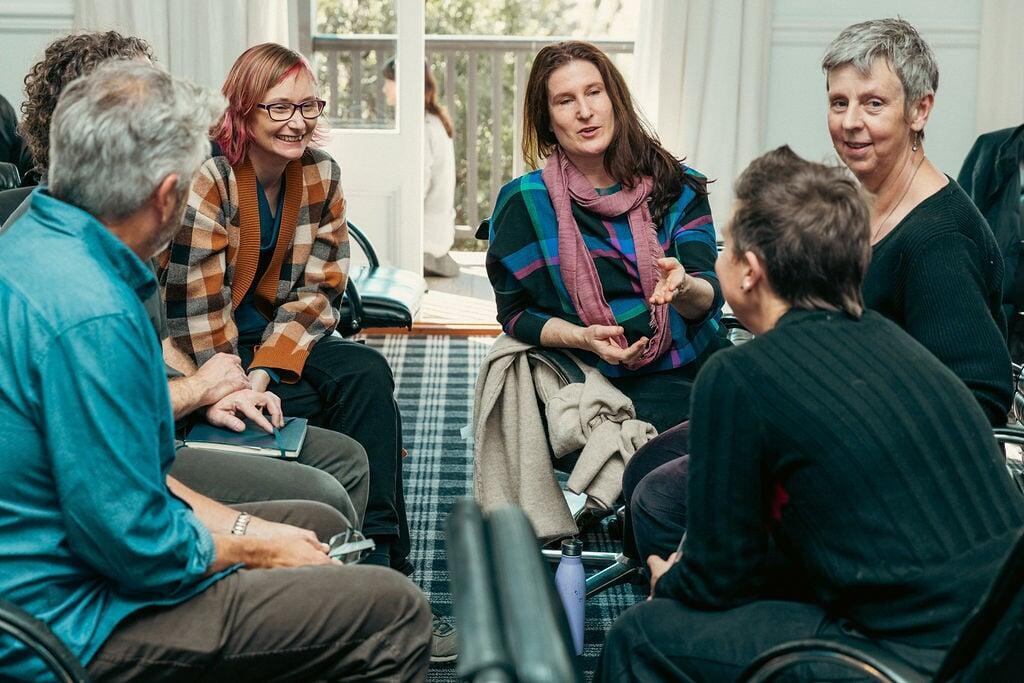
Dialogic relating
The philosopher Martin Buber (1970) distinguished between two fundamental modes of relating: “I-it” relating, where the other is seen as an object to be used or analysed; and “I-thou” relating, where the other is seen in their wholeness. For gestalt therapists, dialogic relating involves the capacity to enter I-thou moments marked by presence and mutuality.
Working in the here-and-now
One of gestalt therapy’s hallmarks is its emphasis on moment-to-moment feelings, sensations, thoughts, and behaviours. This emphasis on the here-and-now does not mean that gestalt therapists view the past and future as unimportant. On the contrary, they see the past as ever-present in clients’ experience as memories, habits, and embodied responses, and the future as existing in clients’ expectations, hopes and fears.
Phenomenological practice
Gestalt therapy is underpinned by phenomenology, which is a philosophy developed by thinkers such as Edmund Husserl, Maurice Merleau-Ponty, and Martin Heidegger. For gestalt therapists, phenomenological practice means staying as close to clients’ actual lived experience as possible, as opposed to interpreting or explaining their experience.
Working with embodied awareness
Gestalt therapy was one of the first modalities to put body awareness at the centre of psychotherapeutic practice. Gestalt therapists pay close attention to the body — breathing, posture, gestures, somatic cues — recognising that the body is not separate from the mind.
Field-sensitive practice
In their seminal gestalt therapy text, Perls, Hefferline, and Goodman (1951) emphasised not the individual, but rather the “organism/environment field”, arguing “it is meaningless to define a breather without air” or “a walker without gravity and ground” (p. 35). The field-sensitive practice of gestalt therapists ensures a wide lens for therapeutic enquiry, recognising that clients’ experiences cannot be separated from the broader context (or, field) of which they are a part.
Working with contacting processes
From its beginnings, gestalt therapy has focused on “contact”, which is the process by which people move towards, interact with, and withdraw from their environment. Gestalt therapists help their clients develop awareness of their habitual ways of making contact, experiment with novel forms of contact, and adopt more flexible and intentional ways of relating to themselves, others, and their life situations.
Experimental attitude
Gestalt therapy’s initial popularity had much to do with Fritz Perls’ dramatic demonstrations of certain experimental techniques, including the “the empty chair” and dreamwork. While gestalt therapy is no longer so closely associated with any particular methods of experimentation, an experimental attitude remains central. Gestalt therapists see therapy as an intrinsically creative process, one that harnesses imagination, curiosity, intuition, and artistry.
References
Buber, M. (1970). I and Thou (W. Kaufmann, Trans.). Scribner.
Fogarty, M. (2015). Creating a Fidelity Scale for Gestalt Therapy. Gestalt Journal of Australia and New Zealand, 11, 2, 39-54.
Perls, F., Hefferline, R., & Goodman, P. (1951/1994). Gestalt Therapy: Excitement and Growth in the Human Personality. The Gestalt Journal Press


